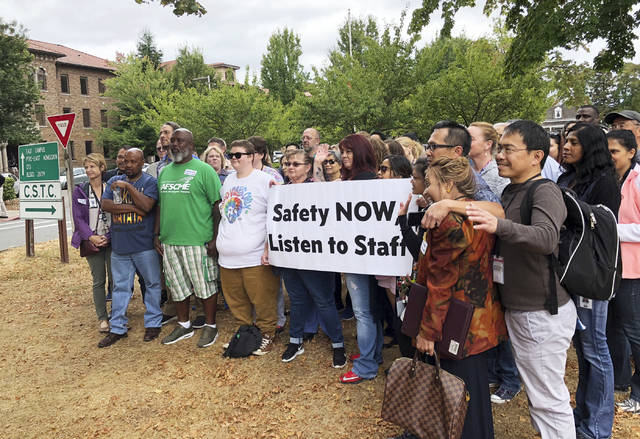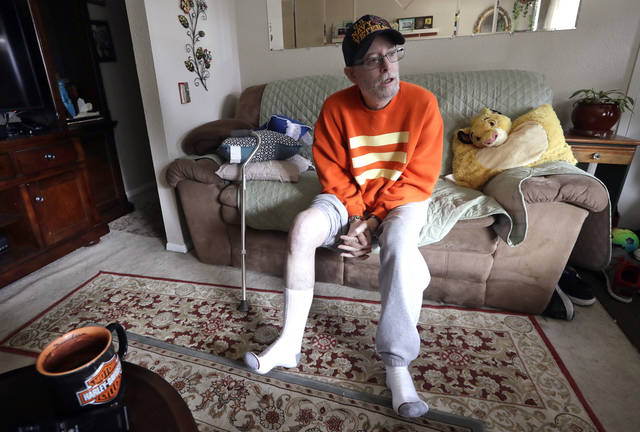APNewsBreak: Assaults increase at Washington mental hospital

In this Aug. 30, 2018 file photo, workers rally demanding changes to the way officials assign dangerous patients to wards at Western State Hospital in Lakewood, Wash. An Associated Press investigation has found assaults on staff and patients at Washington state’s largest psychiatric hospital are on the rise. It also found that disability claims by injured staff topped $5 million in less than three years, and the number of days missed due to injuries has more than doubled since 2016. (AP Photo/Martha Bellisle, File)

In this photo taken Tuesday, Oct. 30, 2018, Western State Hospital nurse Larry Herbert talks about the injury he received after being assaulted by a patient there, as he recovers at his home in Bremerton, Wash. An Associated Press investigation has found assaults on staff and patients at Washington state’s largest psychiatric hospital are on the rise. In the first nine months of 2018, Western State Hospital patients attacked workers 890 times and there were 932 assaults by patients on other patients. It also found that disability claims by injured staff topped $5 million in less than three years. (AP Photo/Elaine Thompson)
BREMERTON, Wash. — The tall, lanky patient walked out of his room at Washington state’s largest psychiatric hospital and spit on two patients before ducking back inside. A few minutes later, he came back out and punched two patients, so Larry Herbert, a licensed practical nurse, went after the man. As Herbert approached, the patient punched him in the face.
BREMERTON, Wash. — The tall, lanky patient walked out of his room at Washington state’s largest psychiatric hospital and spit on two patients before ducking back inside. A few minutes later, he came back out and punched two patients, so Larry Herbert, a licensed practical nurse, went after the man. As Herbert approached, the patient punched him in the face.
Herbert wrapped his arms around the patient, and they wrestled until another worker joined in and they all hit the floor. Herbert’s knee went “snap, snap” as his body twisted in one direction then the other. He ended up in surgery with three torn ligaments and has spent the past six months on the couch, unsure when or if he can return to work.
Attacks like the one on Herbert are on the rise at Western State Hospital, leaving patients, their families and health care workers fearful on a daily basis, an Associated Press investigation has found.
Thousands of nurses, mental health technicians and security guards have been punched, kicked, knocked unconscious, and bitten during patient assaults that resulted in hospitalizations and time off work in recent years, according to interviews and public records obtained by the AP. Disability claims by injured staff topped $5 million in less than three years, and the number of days missed due to injuries has more than doubled since 2016, the records show. The number of patients has remained relatively steady during that period.
Workers blame the hospital administration for an increase in assaults, saying they are failing to provide enough staff and are moving dangerous patients into less-secure wards and leaving them there after they attack others.
“Many employees work 20 or more double shifts per month,” Nursing Supervisor Paul Vilja told the AP. “We are burning out our employees and endangering our patients by not addressing the request for enough permanent staffing.”
Hospital employees who work directly with patients, like nurses and counselors, put in 24,260 overtime hours during the first two weeks of September, at a cost of $944,280, according to payroll records acquired by the AP.
Officials at the Department of Social and Health Services deny that they’re moving dangerous patients into civil-commitment wards and say staffing levels are stable.
“As far as understaffing, there is no understaffing,” agency spokeswoman Kelly Stowe said. The staffing office makes constant adjustments to ensure staffing needs are met by using overtime, calling in temporary workers and pulling staff from other wards, she said.
Another nursing supervisor, Willie Saw, said using “on-call” workers in a psychiatric hospital is problematic because they don’t know the patients and need extra supervision.
The Washington Department of Labor and Industries launched an investigation at the 850-bed hospital in October after especially violent attacks in August and September in which two workers said patients stomped on their heads and another said a patient fractured her spine.
The federal Centers for Medicare and Medicaid Services no longer oversees the facility. The federal agency cut the hospital’s certification and federal funding in June after it continually failed health and safety inspections.
“It’s pretty rare that things get so bad that CMS withdraws certification,” said Ron Honberg, senior policy adviser for the National Alliance on Mental Illness. “That tells you that things are really pretty bad at this point.”
Diana Callison fears for her daughter’s safety. She’s been in and out of the hospital since last year due to court-ordered civil commitments, which found she was a danger to herself or others.
“I am scared to death I am going to lose her,” Callison said. “WSH is such a dangerous place, and I feel it is more so now that there is no federal oversight.”
Washington state recently agreed to pay a $900,000 settlement to Lisa Bowser, whose mother, Sharon Struthers, suffered dozens of falls and assaults during her two-year stay at the hospital.
Bowser told the AP the facility lacked the staff needed to protect patients and said “going there was like going into hell.”
ASSAULTS AND MISSED WORK
The state health services agency documented more than 18,000 assaults by patients on staff and other patients over the past 10 years, but attacks on staff doubled in the past five years after hitting a low of 444 in 2013.
In the first nine months of 2018, patients attacked hospital workers 890 times, compared with 512 assaults for all of 2008, according to agency records. At this rate, the hospital is on track to surpass the 2017 record of 1,058 staff assaults.
Patients are suffering, too. Through September, there were 932 assaults by patients on other patients, the records show.
The attacks make staffing problems worse. Injuries force workers off the job for weeks, months or more than a year, and that time has increased in the past three years, according to Occupational Safety and Health Administration reports.
Injured hospital staff missed 4,601 days of work in 2016; that number jumped to 9,893 days for the first 10 months in 2018, OSHA reports said.
Of the $7 million in injury claims made by staff since 2016, $5.2 million were for “assaults or violent acts by persons.”
Dr. Joel Dvoskin, a psychologist who works as a consultant for psychiatric hospitals in the U.S., said violent behavior in these facilities is “not uncommon,” but the ability to control the assaults depends on staffing and training.
“Any time you see a double in the number of assaults in a few years, that’s bad,” he said.
Saw, the nursing supervisor, says the violence creates a stressful work environment.
“I fear for my safety, but I’m more fearful for the other staff,” Saw said. “There are lots of people who are physically vulnerable.”
MOVING PATIENTS
Hospital staff complain the administration moves dangerous patients from high-security forensics wards to civil-commitment wards, which have fewer safeguards like barriers and Plexiglas, and lighter security.
At an Aug. 30 town hall-style meeting that followed a rally outside the hospital, nurses told hospital CEO Dave Holt that civil-commitment wards are ill-equipped for dangerous patients and that they fear for the chronically mentally ill patients living in those wards.
The hospital’s nurses recently sent “vote of no confidence” petitions to Holt and Washington’s health services agency.
When someone is arrested and found incompetent to stand trial, they’re sent to the hospital’s forensic ward to receive treatment to restore their competency. If treatment fails and the state wants to keep the person in custody for safety reasons, courts will dismiss the criminal charges and order them civilly committed. The patient is “flipped” from the forensics side to the civil side.
The number of forensic flips has varied over the past 10 years. It dropped to 102 in 2015 but this year reached 155 by the end of September, surpassing the 139 cases in all of 2017.
The increase in forensic transfers coincides with the uptick in assaults, records show.
When asked about the increase, Stowe referred the question to the courts. Dan Jackson, with the Washington attorney general’s office, said they handle the cases after they’re referred to their office by the hospital.
“We are not aware of any policy decision related to an increase in referrals,” he said.
Staff say civilly committed patients who are violent should be moved to high-security wards. Stowe said they move violent patients if they commit a “serious assault” while on a civil ward.
But that’s not happening, according to staff.
Several months before patient Christopher Adams Jones fractured nurse Bernia Garner’s spine by jumping over a nursing station and knocking her to the ground, he assaulted Eloisa Panza, a mental health technician, according to a lawsuit filed by Garner.
Panza said Jones pushed her down and bit her leg. The attack forced her to miss three weeks of work. When she returned, Jones was still there. She said he grabbed Garner’s arm on one occasion and then in September, he committed the assault that led to Garner’s lawsuit, in which he also allegedly bit off her earlobe.
Jones was known for targeting female staff, Panza and other workers said.
Stowe declined to comment on Panza’s claims.
NOT GUILTY BY REASON OF INSANITY
Staff also say the administration has moved people found not guilty by reason of insanity, or NGRI, into the civil wards. These are people who have committed serious crimes but were found criminally insane, so they’re held in a secure psychiatric hospital instead of prison. Western State Hospital has special forensic wards for these patients.
When the AP asked how often they’ve transferred NGRI patients out of the forensic wards, Stowe said: “There have been no NGRI patients moved onto civil wards.”
But in December 2017, the Washington Department of Health investigated a complaint about an NGRI patient who was moved to a civil ward, according to the agency’s report.
The man, who had been charged in a double murder, lived on the specialized forensics unit for more than 30 years but was hospitalized for several medical issues, the report said. When he returned to Western State Hospital, they placed him in a civil commitment ward. Staff complained, fearing he might escape — a problem the hospital has faced in the past .
At the end of the investigation, health officials found there was a “cause for corrective action against Western State Hospital.” At the time, the hospital was still in a probationary phase with the Centers for Medicare and Medicaid Services, and health officials said the federal agency would handle the violation.
Holt, the hospital’s CEO, recently sent an email to staff saying employee and patient safety is his No. 1 priority.
“Our team is working on a ‘10-Point Plan’ for safety, including enclosing nurses’ stations and creating an intensive ward for our most dangerous civil patients,” he wrote.
Vilja said he applauds the promise of changes that staff have sought for years, but it’s not enough.
“We demand so much overtime from our staff that the majority of our direct patient care workforce is perpetually exhausted,” he said.

